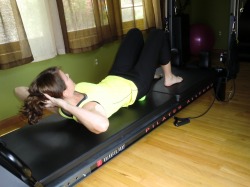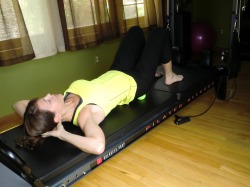A popular author, lecturer, and authority on movement is Eric Franklin. He is a pioneer in the use of imagery for conditioning. He combines scientific principles with movement and imagery exercises to create fluid, relaxed connections between the brain and the body. Many of the instructors at Pilates on Tour used his illustrations from his books Relax You Neck, Liberate Your Shoulders, Dynamic Alignment Through Imagery, and his most recent, Pelvic Power. Franklin hosts world-wide certification programs from Zurich, Switzerland to my own back yard in Pewaukee, WI at Pilates on The Lake. His certification costs $4000 plus hundreds of mentorship hours. His book is $15.95. So to be respectful to my kids' college education funds, as for now, I just purchased his book Pelvic Power.
It is an unusual title and boasts a rather provocative cover which is why I try to avoid leaving it within eye-sight of my kids--or my husband for that matter. It contains however some great training secrets for strengthening the body from the inside out. The pelvic floor supports your inner organs and is also the "antagonist" of important breathing muscles and helps with breathing coordination. In fact the pelvic floor plays an important role in the coordinated triggering of almost all movements, as well as for balance and good body posture. Franklin asserts that many back, knee, and foot problems can be cured through conscious training of the pelvic floor.
The pelvic floor and deepest abdominal muscle (the transverse abdominus) function as antagonistic pairs...when one shortens the other elongates. When one tightens the other relaxes. Another way of considering the relationship as stated by Franklin: a flabby transverse abdominus (protagonist) muscle creates a tense pelvic floor (antagonist.) And a tense muscle is a weak muscle. A comparison may be found within the game of tennis: if the player you are playing against keeps hitting the ball into the net, you won't get a chance to improve. The two players have a relationship to one another even though it is based on opposition. To successfully oppose will also simultaneously strengthen, ideally without excess tension.
One exercise to release tension and generate a connection between the pelvic floor, transverse abdominus and the hip flexor or psoas muscle is easy to perform. The following example from Pelvic Power uses tennis balls to create an ease of motion between the transverse and the pelvic floor. Franklin's book details numerous exercises using balls of approximately 4" in diameter. I just happened to have tennis balls and find they work quite well.
It is an unusual title and boasts a rather provocative cover which is why I try to avoid leaving it within eye-sight of my kids--or my husband for that matter. It contains however some great training secrets for strengthening the body from the inside out. The pelvic floor supports your inner organs and is also the "antagonist" of important breathing muscles and helps with breathing coordination. In fact the pelvic floor plays an important role in the coordinated triggering of almost all movements, as well as for balance and good body posture. Franklin asserts that many back, knee, and foot problems can be cured through conscious training of the pelvic floor.
The pelvic floor and deepest abdominal muscle (the transverse abdominus) function as antagonistic pairs...when one shortens the other elongates. When one tightens the other relaxes. Another way of considering the relationship as stated by Franklin: a flabby transverse abdominus (protagonist) muscle creates a tense pelvic floor (antagonist.) And a tense muscle is a weak muscle. A comparison may be found within the game of tennis: if the player you are playing against keeps hitting the ball into the net, you won't get a chance to improve. The two players have a relationship to one another even though it is based on opposition. To successfully oppose will also simultaneously strengthen, ideally without excess tension.
One exercise to release tension and generate a connection between the pelvic floor, transverse abdominus and the hip flexor or psoas muscle is easy to perform. The following example from Pelvic Power uses tennis balls to create an ease of motion between the transverse and the pelvic floor. Franklin's book details numerous exercises using balls of approximately 4" in diameter. I just happened to have tennis balls and find they work quite well.

Lie on the floor with a tennis ball under each buttock (no, I'm not joking!). Support your head with your hands, lift your head, and tuck your tailbone under a little and observe how the pelvis is tilted with the pubis higher than the hip bones. As you do this tucked position visualize the ischial tuberosities (bottom bones) drawing together as the ASIS (front of the hips) widen.

Reverse the motion and as you rest your head back be aware of how the tuberosities ("bottom bones") draw apart while the front of the hips, the iliac crests come closer to each other. When you tip your pelvis back the spine flexes and the transverse abs elongate. When you tip your pelvis forward (as in a slight arch), the spine extends and the transverse muscle shortens.
When the spine flexes, the pelvic floor tightens and when the spine extends the pelvic floor stretches. Repeat these movements a few times imagining the relationship between the spine, transverse abdominals, psoas and pelvic floor. Take the balls away and enjoy the feeling of a balanced pelvis and lengthened spine.
Thank you to Eric Franklin for his skilled, and unique interpretations of movement. Thank you friends for reading. More power to you!
Thank you to Eric Franklin for his skilled, and unique interpretations of movement. Thank you friends for reading. More power to you!
 RSS Feed
RSS Feed